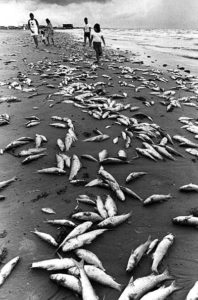Fish Kills
 Harmful algal blooms have devastating impacts on local ecosystems, causing mortality and sickness in organisms across multiple trophic levels. HAB-associated fish kills occur in marine, estuarine, and fresh waters, resulting in economic loss and overall ecosystem degradation. Both aquaculture stocks and wild populations have been affected by these events.
Harmful algal blooms have devastating impacts on local ecosystems, causing mortality and sickness in organisms across multiple trophic levels. HAB-associated fish kills occur in marine, estuarine, and fresh waters, resulting in economic loss and overall ecosystem degradation. Both aquaculture stocks and wild populations have been affected by these events.
Not all fish kills are toxin-associated, and in fact many result from hypoxic (low oxygen) or anoxic (no oxygen) conditions created by blooms. This occurs when night-time respiration of large blooms depletes oxygen from the surrounding water, creating hypoxic zones that are deadly to fish and other organisms. Similar conditions can also occur at blooms termination, during which bacteria break down the dead algal material deplete oxygen from the water.
More directly, fish can be killed by exposure to HAB toxins in the water, or in prey consumed by fish. These toxins have a variety of impacts, ranging from gill damage to disruption of neurologic functions. It should be noted that not all HABs that harm humans produce compounds that are ichthyotoxic (toxic to fish), just as not all ichthyotoxins cause illness in humans. Some common fish-killing algae present in the US are described below:
Additional Resources
Gibble, C.M., Hoover, B.A. 2018. Interactions between seabirds and harmful algal blooms, S.E. Shumway, J.M. Burkholder, S.L. Morton (Eds.), Harmful Algal Blooms: a Compendium Desk Reference, John Wiley & Sons, Ltd., Hoboken, New Jersey (2018), pp. 223-242
Richlen, M.L., Morton, S.L., Jamali, E.A., Rajan, A. and Anderson, D.M., 2010. The catastrophic 2008–2009 red tide in the Arabian Gulf region, with observations on the identification and phylogeny of the fish-killing dinoflagellate Cochlodinium polykrikoides. Harmful algae, 9(2), pp.163-172.
Thronson, A. and Quigg, A., 2008. Fifty-five years of fish kills in coastal Texas. Estuaries and Coasts, 31(4), pp.802-813.
